Oct 27, 2014
Real scientists decimate warmists in a public debate
Gordon,
Well done by all three of you and greatly appreciated the efforts all three of you went to shedding some light of fact on a fictional landscape. I was delighted (and a bit shocked) you were able to negotiate the alarmists going first in the presentations. That is usually an iron-clad rule the politically virulent rarely yield. It must have been traumatic for them to have to sit and listen to reality without being able to pull out the usual inventory mantras of sophistic non-sense to obscure facts. The presentations by Dr. Easterbrook, Dr. Morner and you, if compared to the recent travesty of clown science at the Hammer Museum, hopefully clarifies and separates the critical issues to a few more folks. Wonderful!
DMM
Here is the link to the video of this event.
Gordon Fulks wrote:
Dear All,
The debate went very well, because we had real scientists on our side and the best the other side could muster were two professional propagandists and one weak correspondence-school meteorologist. Since our opponents were heavily into the 97% nonsense, I asked where were their 97 PhD scientists to counter the three of us? The audience easily saw through the attempts of the other side to exaggerate their own credentials and support.
I made sure that those supporting Global Warming went first, because they were the proponents, and we were the opponents. That gave us a clear target, not the nebulous nonsense we usually face. And it was not difficult to anticipate what they would say, because none of our opponents were the least bit sophisticated. The first alarmist to speak was Kyle Dittmer, a hydrologist pretending to be a meteorologist. He sounded like the inept scientist he is, never doing more than vaguely addressing the supposed link between man’s CO2 releases and ‘climate change.’ I’m sure that the audience recognized Dittmer’s weakness.
The succeeding presentations from the other alarmists got worse not better. Their former Greenpeace organizer, Ryan Rittenhouse, lectured the audience about “confirmation bias,” suggesting that it was something we were guilty of and he was not. That was ludicrous on the face of it because of his total lack of any scientific credentials. But he was completely convinced of his righteousness because 97% of scientists and peer-reviewed papers agreed with him! Furthermore, Michael Mann’s ‘Hockey Stick’ had to be correct, because the UN IPCC keeps using it!
Then came the witch Daphne Wysham. Her very first words were a personal attack on Professor Morner that she must have retrieved off the Internet. Then she continued with attacks on Fred Singer, Joe Bast, and the Heartland Institute over Naomi Oreskes’ tobacco allegations and Koch brothers financing. Her only discussion of the actual topic were references to an “unequivocal consensus,” quotes from Skeptical Science, and a harangue about coal-fired power plant ‘carbon pollution’!
Our presentations were far different, because they were filled with the logic and evidence of science. Don Easterbrook spoke first for us and second overall. His very effective technique is to present a great deal of the data that show what is really going on. People instantly realize that they are listening to a professor who surely knows his field very well. Morner sounded a little more eccentric, with his Swedish accent, sense of humor, and concentration on a single topic: seal level. But he was hugely credible too. I batted cleanup and was ready for the sort of nonsense and hatred that Wysham spewed. In fact, all I had to do was to take apart some of her specifics in the three minute rebuttal at the beginning of my remarks and then launch into my prepared text. I went back to prepared remarks to make sure that I did not forget something important in the fifteen minutes we were allotted.
Were we successful? I think that we were very successful. One of the best indications was a compliment from the head librarian who thought that we had been very “educational.” Since that is my entire strategy, it must have worked. But let me be sure to give credit where due. Our opponents were so bad as to help us enormously.
Although we did not have time for questions during the program, I stayed until we had to vacate the room to answer the many good questions that people had. They wanted to discuss the science. The other side slunk away, except for Rittenhouse who was so annoyed that he is still throwing insults our way days later.
Many thanks to Professors Don Easterbrook and Nils Axel Morner for their participation. They both did a great job that made all the difference.
-----------
Global Placebo Effect: Windmills, taxes, solar panels - slowed global warming before they were built.
New Global Placebo Effect (GPE) announced by Baroness Verma in the UK.
It’s a scientific breakthrough. Global warming may be stopped by the mere thought of trying to reduce CO2, even if that thought fails to bring down actual CO2 levels.
The central dilemma: CO2 levels have been rising “faster than expected” for the last twenty years, yet global warming has been rising “slower than expected” for almost as long.
Matt Ridley was questioning Baroness Sandip Verma at the House of Lords this week. He pointed out to the peers that even the IPCC admits there is “hiatus” that modelers can’t explain. Verma responded: “It [global warming] may have slowed down, but that is a good thing. It could well be that some of the measures we are taking today is helping that to occur.” [Source: Dailymail]
Verma raises the intriguing possibility that windmills and solar panels that were built after 2005 have managed to keep global temperatures constant starting from ten years before they were constructed.
What’s even more remarkable is that none of these projects or activities have reduced global CO2 levels. It follows then, that the mere thought of building windmills is enough to change the weather.
Furthermore, it’s well known that more expensive placebo’s are more effective. Hence the final-final copy of the latest IPCC report—issued on Friday after the leak, the draft, and the redraft—will explain that they are 95% certain that if we spend $2 billion dollars a day on renewable energy (instead of just $1 billion) there will be no more category five storms, seas will stop rising, and goats will stop shrinking.
This morning, the UK Prime Minister David Cameron offered to give The Royal Society 350 billion pounds to research the new GPE. Sir Paul Nurse promised to start experiments straight away—beginning by asking seven million British school students to do a coloring in competition on emissions reduction every Monday in 2015 to see how much global temperatures can be reduced compared to other days of the week.
The University of East Anglia announced they will simultaneously set up a new division to monitor Mondays on HadCRUT and also on their Global Climate Models. We don’t know whether models are subject to the placebo effect, but we suspect they might be said a spokesman. The project is due to start in January. Nature has already accepted their paper.
But Dr Roy Spencer was skeptical, and suggested that the correlation may work the other way in models. “The more money we spend on models that predict warming, the less warming we seem to get” said Spencer.
Filed under: satirical press.
Oct 22, 2014
The 2014/15 Winter Forecast from the company that got 2013/14 right
By John Belski, WLKY
Anyone in the weather business knows how difficult forecasting can be at times..... especially a seasonal forecast.
It is even more difficult to get a correct winter forecast several years in a row and yet one company has done that.
WeatherBELL Analytics is a fairly new company.
It was started just a few years ago by Joe Bastardi, former hurricane and long range forecaster for Accuweather.... and Joe D’Aleo, the first Director of Meteorology for The Weather Channel.
They have pretty much nailed the winter forecast in most areas the last several winters.
For example...last winter, while NOAA had 5% of the U.S. with below normal temperatures in their forecast, WeatherBELL was talking cold over much of the country with extreme cold in some areas and that is exactly what happened.
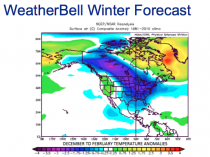
Enlarged

Enlarged
Subscribers to WeatherBELL have received the updated winter forecast this morning. This will eventually be posted on their home page which is free.....click HERE
Here is what they say for this winter.....
It will be between a normal winter and the epic winters of the 1970s.
The core of the coldest weather as far as departure from normal temperatures will be from Pierre, SD to Kansas City to St. Louis to Louisville to Cincinnati to Charleston, WV with temperatures for the winter averaging 4 to 6 degrees below normal.
Last winter in Louisville our temps averaged 4 degrees below normal.... so they are saying it will be colder this winter than last.
They have about 60% of the country averaging more than 2 degrees below normal.
As far as snow, with the cold and forecast storm track.... they have the area that will average the most with respect to above normal amounts from Memphis to Paducah and Bowling Green to Louisville, Lexington and Cincinnati to Pittsburgh to Syracuse.
WeatherBELL has over 90% of the country with normal to above normal snowfall.
If the WeatherBELL forecast is correct for Louisville, the winter will not be quite as cold as the ones in the late 1970’s, but it could be close. Snow amounts with this forecast should top 20 inches and more than 30 inches is certainly a possibility which would lead to a top ten snowiest winter ever.
This will be very interesting to see how it develops. From their past record on what they have done with seasonal forecasts, hurricane predictions and other major weather events.... I trust their forecasts because they have a very high accuracy rate.
----------
Though not the official forecast (which our clients pay for), this is along the lines of what the most similar years tells us for this upcoming winter 2014/15.
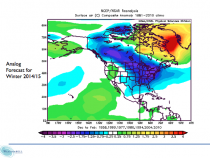
By the way this was the CPC forecast from July 2013 for the winter of 2013/14.

This was Weatherbell’s July forecast for the winter versus the actual.

Enlarged
Oct 09, 2014
“Long-lost” satellite images shed new light on global sea ice…enormous holes found in the arctic
Vencore Weather
"Long-lost” satellite images shed new light on global sea i...enormous holes found in the Arctic ice back in the 1960’s...Antarctica sea ice reached record highs and lows just two years apart
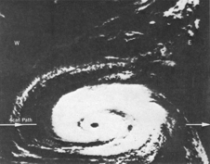
Enlarged
Discussion
Overview
NASA launched the first of seven Nimbus spacecraft to study Earth from space in August 1964 and fifty years later experts at the National Snow and Ice Data Center in Boulder, Colorado are recovering long-lost images from old Nimbus data tapes and black-and-white film. The preliminary findings from long-lost images from the 1960’s have produced some big surprises with respect to global sea ice. In much the same way archeologists dig up artifacts that can rewrite history, these long-lost satellite images have to potential to rewrite our knowledge of ever-changing global sea ice cycles.
The Nimbus program
Fifty years ago NASA launched the first in a series of Earth-observing satellites that revolutionized how scientists study Earth’s weather systems, environment and atmosphere. The Nimbus satellites were a series of seven Earth-observation satellites launched over a 14-year time period from 1964 to 1978, one of which did not achieve orbit. In total, the satellites provided Earth observations for 30 years and collectively carried a total of 33 instruments, including ozone mappers, the Coastal Zone Color Scanner instrument and microwave and infrared radiometers. The Nimbus series were the first meteorological satellites to provide day and night local area coverage every 24-hours, repeated at the same time daily. This “sun-synchronous” orbit became the norm for satellites in subsequent years. Nimbus were also the first satellites to provide day and nighttime pictures of intense hurricanes as viewed from space which initiated the use of satellite technology to provide hurricane warnings (example image above).
Nimbus satellite observations were transmitted as an analog signal and then burned onto film and stored in canisters labeled only by orbit number (i.e., no indication of geography). The only way to retrieve this imagery data into useable format was to scan all of it which meant 250,000 images. Now the satellite imagery data is completely digital and can be managed and manipulated by scientists in order to get a look at the past. Preliminary work with the newly-digitized satellite data has been performed on the 1964-1969 time period and now the year 1970 is being analyzed.
Global Sea Ice
In terms of global sea ice, our current satellite data records are quite good for a little more than the past 30 years or so. Pushing it back another 15 or 20 years could be crucial in the understanding of global sea ice cycles which have been occurring throughout history. Indeed, early findings have been quite surprising with respect to both the Arctic and Antarctica sea ice extent. According to NASA scientists, while there was more ice compared to today, there have been “enormous holes” found in the Arctic ice that “we didn’t expect and can’t explain” in a decade considered to be colder-than-normal (i.e., the 1960’s). The Antarctica sea ice extent findings are perhaps even more amazing. Using these long-lost satellite images, it appears that the Antarctica sea ice extent reached record high levels in 1964 only to be followed by record low amounts just two years later in 1966, and the earliest maximum sea ice extent was seen in 1969. As is often the case with more data, it often leads to more questions than answers. The IPCC had sea ice data in the 1990 report from NOAA.
_thumb.png)
Enlarged
Video discussion on this by NASA scientists:
Steve Goddard presents more proof that the ice periodically shrinks and the arctic warms in this very long collection of media reports from scientists.
Oct 07, 2014
NASA Scientists Puzzled by Global Cooling on Land and Sea
AFP
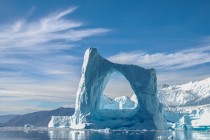
The deep ocean may not be hiding heat after all, raising new questions about why global warming appears to have slowed in recent years, said the US space agency Monday.
Scientists have noticed that while greenhouse gases have continued to mount in the first part of the 21st century, global average surface air temperatures have stopped rising along with them, said NASA.
Some studies have suggested that heat is being absorbed temporarily by the deep seas, and that this so-called global warming hiatus is a temporary trend.
But latest data from satellite and direct ocean temperature measurements from 2005 to 2013 “found the ocean abyss below 1.24 miles (1,995 meters) has not warmed measurably,” NASA said in a statement.
The findings present a new puzzle to scientists, but co-author Josh Willis of NASA’s Jet Propulsion Laboratory (JPL) said the reality of climate change is not being thrown into doubt.
“The sea level is still rising,” said Willis. Yes Willis but at about half the rate of the 20th century - 4 inches vs 7 inches).
“We’re just trying to understand the nitty-gritty details.”
A separate study in August in the journal Science said the apparent slowdown in the Earth’s surface warming in the last 15 years could be due to that heat being trapped in the deep Atlantic and Southern Ocean.
But the NASA researchers said their approach, described in the journal Nature Climate Change, is the first to test the idea using satellite observations, as well as direct temperature measurements of the upper ocean.
“The deep parts of the ocean are harder to measure,” said researcher William Llovel of NASA JPL.
“The combination of satellite and direct temperature data gives us a glimpse of how much sea level rise is due to deep warming. The answer is—not much.”
Sep 30, 2014
Weatherbell had last winter and spring and summer right…how about the winter
Joe D’Aleo, CCM
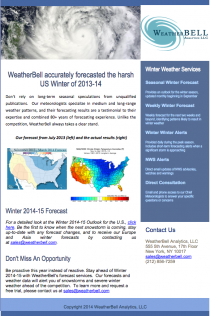
Enlarged
For a detailed look back at 2013/14 and ahead at the Winter 2014-15 Outlook for the U.S., click here. Come to weatherbell.com to sign up for access the the world’s best models and blogs. Be the first to know when the next snowstorm is coming, stay up-to-date with any forecast changes, and to receive our Europe and Asia winter forecasts by contacting us at sales@weatherbell.com.
Obvious failure of climate science that mainstream media ignores
Bob Tisdale
The National Science Foundation press release Cause of California drought linked to climate change found its way into the mainstream media, with science reporters around the globe adding their hype. That press release is based on the recently published study Swain et al. (2014) “The Extraordinary California Drought of 2013/2014: Character, Context and the Role of Climate Change, which can be found in the Special Supplement to the Bulletin of the American Meteorological Society (BAMS report)Vol. 95, No. 9, September 2014, Explaining Extreme Events of 2013 From A Climate Perspective.
I’ll publish a few comments about Swain et al. (2014) in a few days. But this post is not about that paper.
THE CALIFORNIA DROUGHT - WHO’S TO BLAME FOR THE LACK OF PREPAREDNESS?
As I was reading Anthony Watts excellent post about Swain et al. (2014), Claim: Cause of California drought linked to climate change - not one mention of ENSO or El Nino, a number of reoccurring thoughts replayed, thoughts that have struck me numerous times as the Western States drought unfolded last year and intensified this year.
Was California prepared for a drought?
Obviously, California was not prepared for a drought this intense, and the impacts of that lack of preparedness on California residents will grow much worse if the drought continues.
Why wasn’t California prepared for a short-term (multiyear) drought this intense?
The realistic blame should be the focus of climate science in general under the direction of the IPCC. In the opening paragraph of the IPCC’s History webpage, they state (my boldface and caps):
Today the IPCC’s role is as defined in Principles Governing IPCC Work, “...to assess on a comprehensive, objective, open and transparent basis the scientific, technical and socio-economic information relevant to understanding the scientific basis of risk of HUMAN-INDUCED climate change, its potential impacts and options for adaptation and mitigation.
The fact that the IPCC has focused all of their efforts on “understanding the scientific basis of risk of human-induced climate change” is very important. The IPCC has never realistically tried to determine if natural factors could have caused most of the warming the Earth has experienced over the past century. For decades, they’ve worn blinders that blocked their views of everything other than the possible impacts of carbon dioxide. The role of the IPCC has always been to prepare reports that support the reduction of greenhouse gas emissions caused by the burning of fossil fuels. As a result, that’s where all of the research money goes. The decision to only study human-induced global warming is a political choice, not a scientific one. In efforts to justify agendas, politicians around the world jumped on the climate change stump and funded computer model-based studies of human-induced global warming...to the tune of billions of dollars annually.
Because of that political agenda, the latest and greatest climate models still cannot simulate the basic underlying processes that govern the naturally occurring, coupled ocean-atmosphere processes like ENSO (El Ninos and La Ninas), like the Pacific Decadal Oscillation...processes that have strong influences on temperature and precipitation in west coast states. So there is no possible way climate models, as they exist today, could forecast what precipitation might be like in the future there. And that basic problem will persist until there is a redirection of climate-research funding. Yes, funding. Research follows the money.
What value do climate model-based studies provide?
None.
The paper Pierce et al. (2013) The Key Role of Heavy Precipitation Events in Climate Model Disagreements of Future Annual Precipitation Changes in California provides an overview of why the climate models have no value when it comes to forecasts like California drought. In their abstract Pierce et al. write (my boldface and caps):
Of the 25 downscaled model projections examined here, 21 agree that precipitation frequency will DECREASE by the 2060s, with a mean reduction of 6-14 days yr−1. This reduces California’s mean annual precipitation by about 5.7%. Partly offsetting this, 16 of the 25 projections agree that daily precipitation intensity will INCREASE, which accounts for a model average 5.3% increase in annual precipitation. Between these conflicting tendencies, 12 projections show drier annual conditions by the 2060s and 13 show wetter.
[Hat tip to blogger “Jimbo” on the WUWT thread Claim: Cause of California drought linked to climate change [ not one mention of ENSO or El Nino.]
So some climate models say that daily precipitation intensity will increase and others say it will decrease. In other words, the climate science community is clueless about what the future might bring for west coast precipitation.
Some might say that climatologists for the State of California and other west coast states have been hampered by climate science. It’s tough to make recommendations to state and local governments for long-term planning when the climate science community provides them with nothing to work with.
Is California prepared for a drought that lasts multiple decades or even centuries?
Anthony Watts’s post included a graph from a paleoclimatological study of West Coast drought that showed past droughts have lasted for hundreds of years. For the original graph and discussion, see Figure 10 of Cook et al. (2007) North American drought: Reconstructions, causes, and consequences. (Note: That’s not the John Cook from SkepticalScience.)
Now I hate to make you think about bad news. But if it’s happened in the past, can it happen again?
Why are mainstream media simply parroting press releases?
Climate-change news reports have become echo chambers of the press releases put out by colleges, universities and government research agencies. Individual reporters might provide a more in-depth report by asking the scientist-authors for a few extra word of wisdom.
But why aren’t the media asking the tough questions, like:
Why weren’t west-coast residents warned 10 or 15 years ago that a severe drought is just a weather anomaly away?
Why aren’t there enough desalinization plants in place to supplement rainfall deficits?
Why are the people of the west coast protesting for, and why are state governments funding, more wind farms and solar arrays when they need something more basic to maintain life there, water?
Seems to me we may very soon be seeing a reversal of Steinbeck’s The Grapes of Wrath, with vast flocks of California residents migrating back to the Midwest, which also is subject to periodic droughts.
Poor planning on the parts of a few - based on politically motivated, unsound science - may make for emergencies for millions.
|









_thumb.png)

